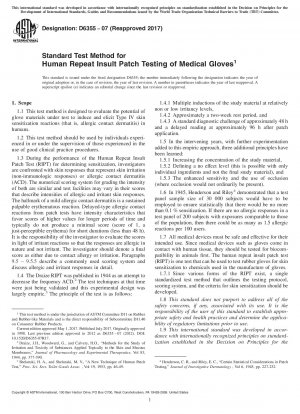ASTM D6355-07(2017)
Standard Test Method for Human Repeat Insult Patch Testing of Medical Gloves
- Standard No.
- ASTM D6355-07(2017)
- Release Date
- 2007
- Published By
- American Society for Testing and Materials (ASTM)
- Status
- Replace By
- ASTM D6355-07(2022)
- Latest
- ASTM D6355-07(2022)
- Scope
-
4.1 This RIPT method assesses the potential of skin sensitization with a particular medical product by repeated topical applications to the skin of selected subjects. This is a procedure that has the potential to detect many, but not all, sensitzers. This requires multiple applications to induce a cell-mediated Type IV immune response sufficient to cause an allergic reaction.
4.2 In general, the sensitization procedure requires 10 multiple 48-h (72-h on weekends) applications of patches containing the study material over a three-week induction phase. Induction is followed by approximately a 21 day rest phase to allow the development of any latent sensitization. Study subjects are then challenged by the application of two consecutive 48-h patches of the study material to naive sites. Responses are evaluated and graded after the removal of each consecutive 48-h patch application.
4.3 Although this test method is a clinical method, it may be used as part of a risk analysis to determine the potential for Type IV allergic contact dermatitis.
4.4 This test method assumes that good clinical practices will be utilized, including adequate training of practitioners.
1.1 This test method is designed to evaluate the potential of glove materials under test to induce and elicit Type IV skin sensitization reactions (that is, allergic contact dermatitis) in humans.
1.2 This test method should be used by individuals experienced in or under the supervision of those experienced in the use of good clinical practice procedures.
1.3 During the performance of the Human Repeat Insult Patch Test (RIPT) for determining sensitization, investigators are confronted with skin responses that represent skin irritation (non-immunologic responses) or allergic contact dermatitis (ACD). The numerical scoring system for grading the intensity of both are similar and test facilities may vary in their scores that describe intensities of allergic and irritant skin responses. The hallmark of a mild allergic contact dermatitis is a sustained palpable erythematous reaction. Delayed-type allergic contact reactions from patch tests have intensity characteristics that favor scores of higher values for longer periods of time and typically do not produce a minimal score (score of 1, a just-perceptible erythema) for short durations (less than 48 h). It is the responsibility of the investigator to evaluate the scores in light of irritant reactions so that the responses are allergic in nature and not irritant. The investigator should denote a final score as either due to contact allergy or irritation. Paragraphs 9.5 – 9.5.5 describe a commonly used scoring system and discuss allergic and irritant responses in detail.
1.4 The Draize RIPT was published in 1944 as an attempt to decrease the frequency ACD.2 The test techniques at that time were just being validated and this expe......
ASTM D6355-07(2017) history
- 2022 ASTM D6355-07(2022) Standard Test Method for Human Repeat Insult Patch Testing of Medical Gloves
- 2007 ASTM D6355-07(2017) Standard Test Method for Human Repeat Insult Patch Testing of Medical Gloves
- 2007 ASTM D6355-07(2012) Standard Test Method for Human Repeat Insult Patch Testing of Medical Gloves
- 2007 ASTM D6355-07 Standard Test Method for Human Repeat Insult Patch Testing of Medical Gloves
- 1998 ASTM D6355-98(2003) Standard Test Method for Human Repeat Insult Patch Testing of Medical Gloves
- 1998 ASTM D6355-98 Standard Test Method for Human Repeat Insult Patch Testing of Medical Gloves

Copyright ©2024 All Rights Reserved